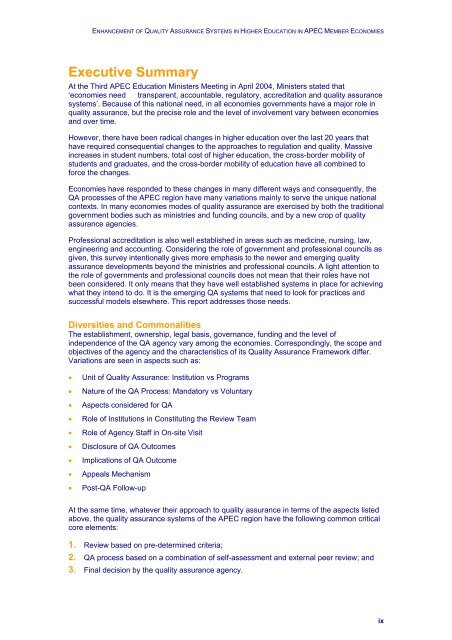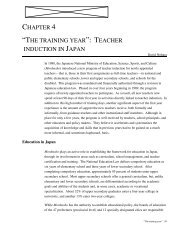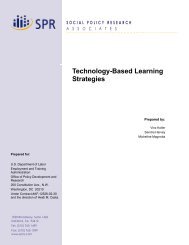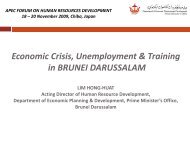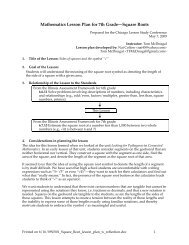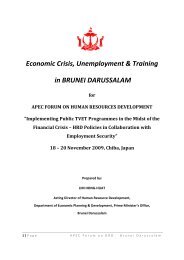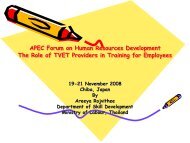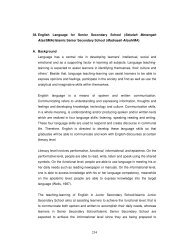Quality Assurance Systems in Asia-Pacific Economic Cooperation
Quality Assurance Systems in Asia-Pacific Economic Cooperation
Quality Assurance Systems in Asia-Pacific Economic Cooperation
You also want an ePaper? Increase the reach of your titles
YUMPU automatically turns print PDFs into web optimized ePapers that Google loves.
ENHANCEMENT OF QUALITY ASSURANCE SYSTEMS IN HIGHER EDUCATION IN APEC MEMBER ECONOMIES<br />
Executive Summary<br />
At the Third APEC Education M<strong>in</strong>isters Meet<strong>in</strong>g <strong>in</strong> April 2004, M<strong>in</strong>isters stated that<br />
‘economies need transparent, accountable, regulatory, accreditation and quality assurance<br />
systems’. Because of this national need, <strong>in</strong> all economies governments have a major role <strong>in</strong><br />
quality assurance, but the precise role and the level of <strong>in</strong>volvement vary between economies<br />
and over time.<br />
However, there have been radical changes <strong>in</strong> higher education over the last 20 years that<br />
have required consequential changes to the approaches to regulation and quality. Massive<br />
<strong>in</strong>creases <strong>in</strong> student numbers, total cost of higher education, the cross-border mobility of<br />
students and graduates, and the cross-border mobility of education have all comb<strong>in</strong>ed to<br />
force the changes.<br />
Economies have responded to these changes <strong>in</strong> many different ways and consequently, the<br />
QA processes of the APEC region have many variations ma<strong>in</strong>ly to serve the unique national<br />
contexts. In many economies modes of quality assurance are exercised by both the traditional<br />
government bodies such as m<strong>in</strong>istries and fund<strong>in</strong>g councils, and by a new crop of quality<br />
assurance agencies.<br />
Professional accreditation is also well established <strong>in</strong> areas such as medic<strong>in</strong>e, nurs<strong>in</strong>g, law,<br />
eng<strong>in</strong>eer<strong>in</strong>g and account<strong>in</strong>g. Consider<strong>in</strong>g the role of government and professional councils as<br />
given, this survey <strong>in</strong>tentionally gives more emphasis to the newer and emerg<strong>in</strong>g quality<br />
assurance developments beyond the m<strong>in</strong>istries and professional councils. A light attention to<br />
the role of governments and professional councils does not mean that their roles have not<br />
been considered. It only means that they have well established systems <strong>in</strong> place for achiev<strong>in</strong>g<br />
what they <strong>in</strong>tend to do. It is the emerg<strong>in</strong>g QA systems that need to look for practices and<br />
successful models elsewhere. This report addresses those needs.<br />
Diversities and Commonalities<br />
The establishment, ownership, legal basis, governance, fund<strong>in</strong>g and the level of<br />
<strong>in</strong>dependence of the QA agency vary among the economies. Correspond<strong>in</strong>gly, the scope and<br />
objectives of the agency and the characteristics of its <strong>Quality</strong> <strong>Assurance</strong> Framework differ.<br />
Variations are seen <strong>in</strong> aspects such as:<br />
<br />
<br />
<br />
<br />
<br />
<br />
<br />
<br />
<br />
Unit of <strong>Quality</strong> <strong>Assurance</strong>: Institution vs Programs<br />
Nature of the QA Process: Mandatory vs Voluntary<br />
Aspects considered for QA<br />
Role of Institutions <strong>in</strong> Constitut<strong>in</strong>g the Review Team<br />
Role of Agency Staff <strong>in</strong> On-site Visit<br />
Disclosure of QA Outcomes<br />
Implications of QA Outcome<br />
Appeals Mechanism<br />
Post-QA Follow-up<br />
At the same time, whatever their approach to quality assurance <strong>in</strong> terms of the aspects listed<br />
above, the quality assurance systems of the APEC region have the follow<strong>in</strong>g common critical<br />
core elements:<br />
1. Review based on pre-determ<strong>in</strong>ed criteria;<br />
2. QA process based on a comb<strong>in</strong>ation of self-assessment and external peer review; and<br />
3. F<strong>in</strong>al decision by the quality assurance agency.<br />
ix


